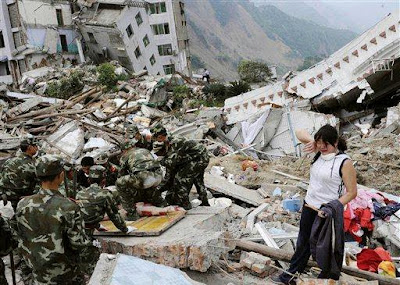 | |
| Date | May 12, 2008 |
|---|---|
| Magnitude | 8.0 Ms[1] / 7.9 Mw[2] |
| Depth | 19 kilometres (12 mi) |
| Epicenter location |  31°01′16″N 103°22′01″E / 31.021°N 103.367°E (Yingxiu, Wenchuan, Ngawa in Sichuan Province) 31°01′16″N 103°22′01″E / 31.021°N 103.367°E (Yingxiu, Wenchuan, Ngawa in Sichuan Province) |
| Countries or regions affected | |
| Max. intensity | XI – Very Disastrous (MM,[3] Liedu[4]) |
| Aftershocks | 149 to 284 major over 42,719 total[5] |
| Casualties | 68,712 dead (21st deadliest earthquake of all time)17,921 missing[6] 374,643 injured |
The 2008 Sichuan earthquake or the Great Sichuan Earthquake was a deadly earthquake that measured at 8.0 Ms and 7.9 Mw occurred at 14:28:01.42 CST (06:28:01.42 UTC) on May 12, 2008 in Sichuan province of China and killed at least 68,000 people.
It is also known as the Wenchuan earthquake (Chinese: 汶川大地震; pinyin: Wènchuān dà dìzhèn), after the location of the earthquake's epicenter, Wenchuan County in Sichuan province. The epicenter was 80 kilometres (50 mi) west-northwest of Chengdu, the capital of Sichuan, with a focal depth of 19 kilometres (12 mi). The earthquake was also felt in nearby countries and as far away as both Beijing and Shanghai—1,500 kilometres (932 mi) and 1,700 kilometres (1,056 mi) away—where office buildings swayed with the tremor.
Official figures (as of July 21, 2008 12:00 CST) state that 69,197 are confirmed dead, including 68,636 in Sichuan province, and 374,176 injured, with 18,222 listed as missing . The earthquake left about 4.8 million people homeless, though the number could be as high as 11 million. Approximately 15 million people lived in the affected area. It was the deadliest earthquake to hit China since the 1976 Tangshan earthquake, which killed at least 240,000 people, and the strongest since the 1950 Chayu earthquake in the country, which registered at 8.5 on Richter magnitude scale. It is the 21st deadliest earthquake of all time.
Strong aftershocks, some exceeding magnitude 6, continued to hit the area even months after the main quake, causing new casualties and damage.
On November 6, 2008, the central government announced that it will spend 1 trillion yuan (about $146.5 billion) over the next three years to rebuild areas ravaged by the earthquake.
It is also known as the Wenchuan earthquake (Chinese: 汶川大地震; pinyin: Wènchuān dà dìzhèn), after the location of the earthquake's epicenter, Wenchuan County in Sichuan province. The epicenter was 80 kilometres (50 mi) west-northwest of Chengdu, the capital of Sichuan, with a focal depth of 19 kilometres (12 mi). The earthquake was also felt in nearby countries and as far away as both Beijing and Shanghai—1,500 kilometres (932 mi) and 1,700 kilometres (1,056 mi) away—where office buildings swayed with the tremor.
Official figures (as of July 21, 2008 12:00 CST) state that 69,197 are confirmed dead, including 68,636 in Sichuan province, and 374,176 injured, with 18,222 listed as missing . The earthquake left about 4.8 million people homeless, though the number could be as high as 11 million. Approximately 15 million people lived in the affected area. It was the deadliest earthquake to hit China since the 1976 Tangshan earthquake, which killed at least 240,000 people, and the strongest since the 1950 Chayu earthquake in the country, which registered at 8.5 on Richter magnitude scale. It is the 21st deadliest earthquake of all time.
Strong aftershocks, some exceeding magnitude 6, continued to hit the area even months after the main quake, causing new casualties and damage.
On November 6, 2008, the central government announced that it will spend 1 trillion yuan (about $146.5 billion) over the next three years to rebuild areas ravaged by the earthquake.


No comments:
Post a Comment